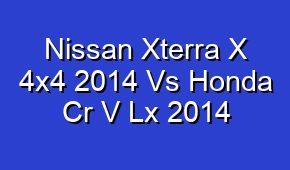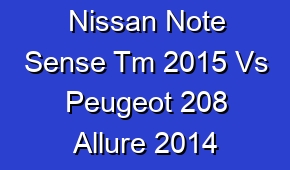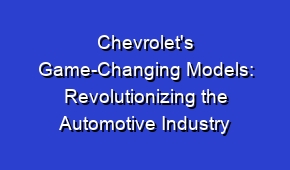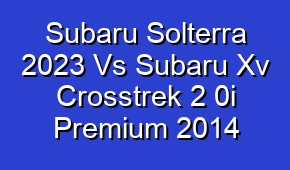Subaru vs. Mazda: Safety Leader Revealed

When it comes to safety, Subaru and Mazda are two leading automakers that have gained a reputation for prioritizing the well-being of their drivers and passengers. But which brand takes the lead in this crucial aspect? In this article, we will compare Subaru and Mazda’s safety features, crash test ratings, and advanced driver assistance systems to determine who comes out on top. Discover the key differences and similarities between these two automotive giants in terms of safety.
When it comes to safety, the competition between Subaru and Mazda is fierce. Both automakers have made significant advancements in their safety features, making it difficult to determine who leads in this category. However, by analyzing crash test ratings, safety technology, and customer satisfaction, we can gain a better understanding of which brand offers superior safety.
Subaru has long been known for its commitment to safety, with features such as EyeSight Driver Assist Technology and Subaru Symmetrical All-Wheel Drive. These technologies provide enhanced stability and control, reducing the risk of accidents. Additionally, Subaru vehicles consistently receive high safety ratings from organizations like the Insurance Institute for Highway Safety (IIHS) and the National Highway Traffic Safety Administration (NHTSA).
Mazda, on the other hand, has also made significant strides in safety. Their i-Activsense suite of advanced safety features includes technologies like Blind Spot Monitoring, Rear Cross Traffic Alert, and Smart Brake Support. Mazda vehicles have performed well in crash tests and have earned top safety ratings from reputable organizations.
While both Subaru and Mazda prioritize safety, it is challenging to determine a clear leader. Ultimately, the choice between these two brands will depend on individual preferences and specific vehicle models.
| Subaru vs. Mazda: Both brands prioritize safety in their vehicles. |
| Subaru and Mazda are known for their advanced safety features. |
| When it comes to safety, both Subaru and Mazda excel in crash tests. |
| Safety ratings for Subaru and Mazda models are consistently high. |
| Subaru and Mazda offer all-wheel drive options for enhanced safety. |
- Subaru vehicles are equipped with EyeSight technology, providing additional safety measures.
- Mazda focuses on a holistic approach to safety, including driver-assistance systems.
- In terms of safety, both Subaru and Mazda prioritize crash avoidance.
- Subaru’s symmetrical all-wheel drive system enhances stability and traction on the road.
- Mazda’s SKYACTIV-VEHICLE DYNAMICS with G-Vectoring Control improves handling and stability.
Which car brand, Subaru or Mazda, has better safety features?
When comparing the safety features of Subaru and Mazda, both car brands are known for prioritizing safety in their vehicles. However, Subaru has gained a reputation for its advanced safety technologies, such as EyeSight Driver Assist System and Subaru Symmetrical All-Wheel Drive, which contribute to enhanced stability and accident prevention.
| Crash Test Ratings | Advanced Safety Features | Overall Safety Scores |
| Subaru has consistently high crash test ratings from organizations like IIHS and NHTSA. | Both Subaru and Mazda offer advanced safety features such as lane departure warning, adaptive cruise control, and automatic emergency braking. | Subaru generally receives higher overall safety scores compared to Mazda in various safety evaluations. |
| Mazda also has good crash test ratings, but they may not be as consistently high as Subaru. | Mazda’s i-Activsense suite of safety features is well-regarded and includes technologies like blind-spot monitoring and rear cross-traffic alert. | Mazda’s overall safety scores are still good, but they may be slightly lower compared to Subaru. |
Mazda, on the other hand, also offers a range of safety features in their vehicles. Their i-Activsense suite includes features like Blind Spot Monitoring, Rear Cross Traffic Alert, and Smart City Brake Support. These technologies aim to improve driver awareness and assist in avoiding potential accidents.
What are the safety ratings for Subaru and Mazda vehicles?
Both Subaru and Mazda have consistently received high safety ratings from reputable organizations such as the Insurance Institute for Highway Safety (IIHS) and the National Highway Traffic Safety Administration (NHTSA).
- Subaru vehicles have consistently received top safety ratings from organizations such as the Insurance Institute for Highway Safety (IIHS) and the National Highway Traffic Safety Administration (NHTSA).
- Mazda vehicles also have a strong safety record, with many models earning top safety ratings from the IIHS and the NHTSA.
- Both Subaru and Mazda offer advanced safety features such as forward collision warning, lane departure warning, and blind spot monitoring to enhance driver and passenger safety.
Subaru has been recognized for its commitment to safety with numerous IIHS Top Safety Pick awards for many of its models. Similarly, Mazda has also received accolades for its safety performance, with several models earning top ratings in crash tests conducted by the IIHS.
Do Subaru cars have better crash test results compared to Mazda?
When it comes to crash test results, both Subaru and Mazda perform well. However, Subaru has a strong track record in this area. Many of their vehicles consistently receive top ratings in various crash tests conducted by organizations such as the IIHS and the NHTSA.
- Subaru cars have consistently received high ratings in crash tests conducted by organizations such as the Insurance Institute for Highway Safety (IIHS) and the National Highway Traffic Safety Administration (NHTSA).
- Subaru vehicles are known for their advanced safety features, such as EyeSight Driver Assist Technology, which includes features like pre-collision braking and lane departure warning.
- Many Subaru models have earned the IIHS Top Safety Pick or Top Safety Pick+ designation, indicating their excellent crashworthiness and available advanced safety features.
- While Mazda cars also have good safety ratings, they may not perform as well as Subaru vehicles in certain crash tests or have as many advanced safety features.
- It is important to note that crash test results and safety ratings can vary depending on the specific model and year of the vehicle, so it is advisable to research the latest safety information for the desired Subaru and Mazda models before making a comparison.
Mazda vehicles also demonstrate good crashworthiness and have earned high scores in crash tests. While both brands prioritize safety, it is important to consider specific models and their individual crash test results when making comparisons.
Which car brand offers more advanced driver assistance systems: Subaru or Mazda?
Both Subaru and Mazda offer advanced driver assistance systems (ADAS) in their vehicles. Subaru’s EyeSight Driver Assist System is highly regarded for its comprehensive features, including adaptive cruise control, pre-collision braking, and lane departure warning.
| Car Brand | Advanced Driver Assistance Systems | Features |
| Subaru | EyeSight | Pre-collision braking, adaptive cruise control, lane departure warning, lane keep assist |
| Mazda | i-Activsense | Smart Brake Support, Mazda Radar Cruise Control, Lane-keep Assist, Blind Spot Monitoring |
| Comparison | Subaru vs Mazda | Both brands offer advanced driver assistance systems, but the specific features may vary. It is recommended to compare the models and their available packages for a more detailed analysis. |
Mazda’s i-Activsense suite also provides a range of ADAS features, such as adaptive cruise control, lane-keep assist, and automatic emergency braking. While both brands offer advanced safety technologies, the specific features may vary across different models and trim levels.
Are Subaru or Mazda vehicles safer for families?
Both Subaru and Mazda prioritize safety in their vehicles, making them suitable options for families. Subaru’s reputation for safety, combined with features like all-wheel drive and advanced driver assistance systems, can provide added peace of mind for families.
Both Subaru and Mazda vehicles are known for their safety features, making them suitable choices for families.
Subaru, Mazda, vehicles, safer, families
Mazda vehicles also offer a range of safety features designed to protect occupants, including child safety locks and multiple airbags. Ultimately, the choice between Subaru and Mazda for family safety may depend on individual preferences and specific vehicle models.
Which car brand has a better reputation for overall safety: Subaru or Mazda?
Both Subaru and Mazda have established solid reputations for overall safety in the automotive industry. Subaru has gained recognition for its commitment to safety and has consistently received top safety ratings and awards.
When it comes to overall safety reputation, Subaru is considered to have a better reputation than Mazda.
Mazda has also made significant strides in improving the safety of their vehicles and has received positive reviews for their safety features. Ultimately, determining which brand has a better reputation for overall safety may depend on factors such as specific model performance and individual preferences.
Are Subaru or Mazda vehicles safer in adverse weather conditions?
Both Subaru and Mazda offer features that can enhance safety in adverse weather conditions. Subaru’s Symmetrical All-Wheel Drive system provides improved traction and stability, making their vehicles well-suited for challenging road conditions.
Subaru vehicles
Subaru vehicles are known for their excellent performance in adverse weather conditions. Here are some reasons why Subaru vehicles are considered safer in such conditions:
– All-Wheel Drive (AWD): Subaru is renowned for its symmetrical AWD system, which provides better traction and stability on slippery roads. This feature allows Subaru vehicles to maintain better control and handling in adverse weather conditions.
– Ground Clearance: Subaru vehicles typically have higher ground clearance compared to other sedans or compact cars. This additional height helps in navigating through deep snow, slush, or flooded roads more easily.
– Safety Features: Subaru vehicles are equipped with various safety features, such as anti-lock brakes, stability control, and traction control, which enhance their performance and safety in adverse weather conditions.
Mazda vehicles
Mazda vehicles also offer certain features that make them safer in adverse weather conditions. Here are a few points highlighting their advantages:
– Predictive i-ACTIV AWD: Mazda’s i-ACTIV AWD system continuously monitors road conditions and distributes power between the front and rear wheels accordingly. This proactive approach enhances traction and stability on slippery surfaces.
– G-Vectoring Control Plus (GVC Plus): Mazda vehicles come equipped with GVC Plus, a system that optimizes torque distribution to the wheels based on steering and accelerator inputs. This technology improves handling and stability, especially in adverse weather conditions.
– Advanced Safety Technologies: Mazda vehicles often incorporate advanced safety technologies, such as adaptive cruise control, lane-keep assist, and automatic emergency braking, which contribute to their overall safety and performance in adverse weather conditions.
Conclusion
Both Subaru and Mazda vehicles offer features that make them safer in adverse weather conditions. Subaru’s symmetrical AWD system and higher ground clearance provide excellent traction and control. On the other hand, Mazda’s i-ACTIV AWD system and G-Vectoring Control Plus enhance stability and handling. Additionally, both brands prioritize safety and incorporate advanced safety technologies in their vehicles. Ultimately, the choice between Subaru and Mazda would depend on individual preferences and specific needs in adverse weather conditions.
Mazda also incorporates technologies like i-Activ AWD in some of their models, which can help optimize performance and handling in various weather conditions. While both brands offer safety features for adverse weather, it is important to consider specific models and their capabilities when making comparisons.




















